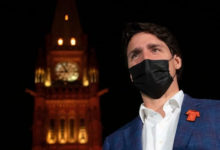“Status Indian” in Canada
Leigh MacDonald Costa was born in an indigenous family and was adopted into a Polish/Scottish family when she was a child.

Costa grew up in Scarborough and there were only three more Indigenous people in the neighbourhood. Leigh MacDonald Costa shared their thoughts about some dark statistics regarding Indigenous people, one of the most controversial chapters of Canadian history.
Milénio Stadium: Indigenous voice can be heard in Ottawa?
Leigh MacDonald Costa: I don’t think it’s incorrect to say that indigenous representation in Ottawa is grossly underrepresented. I believe Dan Vandel, the Minister of Northern Affairs, is the only Indigenous MP at Trudeau’s cabinet. The Indigenous Services Minister, although fluent in Mohawk, is not Indigenous. Historically, the Canadian government has made decisions regarding the Indigenous people in Canada that have been devastatingly harmful. Decisions that included abuse, loss of culture and even death; and resulted in isolation, addiction and mental health struggles due to PTSD (Post-Traumatic Stress Disorder). Even the implementation of reservations was culturally damaging. Indigenous people were nomadic hunter gatherers. That was the way of life for thousands of years. Within a couple short centuries that was taken away and Native communities were given plots of land to live on. That is not how the traditional way of life was lived. On my reserve there is still lots of fish and game to hunt. I couldn’t imagine being segregated on a remote piece of land, only accessible by plane with no access to clean water. The traditional way of life is not even possible. That’s the reality for many remote northern communities. What I’m trying to say here is that the Canadian government hasn’t made good decisions regarding First Nations. I would think that those who could make the best decisions for Indigenous communities would be the Indigenous people. The Canadian government has historically victimized Indigenous people and we get compensated financially for our trouble (Residential schools, 60s Scoop, Child Welfare Discrimination). Giving monetary compensation is a band-aid solution for wrongs that shouldn’t have been made in the first place. Although there are lots of Indigenous issues being discussed in Ottawa and decisions for the Indigenous people being made, none of the decision makers are Indigenous.
MS: 99 First Nations communities have had a boil water advisory in place for more than a year.
LMC: I read in the Globe and Mail that there was a northern Ontario reserve that had a boil-water advisory for almost 25 years and that 56 First Nations across Canada also have long-term boil-water advisories. I have never lived on my reserve which is located on the Trans-Canada highway between Sudbury and Sault Ste. Marie. My own reserve’s long-term drinking water advisory was lifted in November 2018 after the filtration plant which broke down three years prior was repaired. What I was shocked to learn was that a reserve 30 minutes from where I live does have a boil water advisory and that many of the homes on that reserve don’t have running water. I have been to Six Nations of the Grand River many times. I’ll stop in for tax-exempt gas if I’m in the area and to me, Six Nations looks like an average community. I had no idea that only 9% of households have access to clean running water. This is 30 minutes from Hamilton and only minutes from Caledonia. Both of those communities have clean running water. So my question is how does a First Nation community in the middle of several cities (Hamilton, Caledonia and Brantford) have no clean running water when all the communities around it does. It makes you wonder whose health is valued most in Canada when these water advisories are all on First Nations. I’m hoping that Justin Trudeau keeps his promise of having all water advisories lifted by 2021 because having third world conditions in a 1st world country is unacceptable.
MS: 47% of all First Nations children live in poverty.
LMC: That’s actually 47% of status First Nations children, so children who live on the reserve. That’s a hard percentage to swallow for a country as rich as Canada. Something that has always struck me being a “status Indian” myself, is the misconception that the average Canadian has of all the “free stuff” we (meaning “status Indians”) get. I have no idea what they are talking about. I pay taxes just like everyone else; this would only change if I lived and worked on the reserve. But according to this statistic, that wouldn’t be so beneficial if 47% of the children living on reserve live below the poverty line. These rates haven’t shown improvement in 14 years and First Nations children living on reserve have been underfunded by the Federal Government since 1996 when budgets were locked and not increased due to inflation; much like the Robinson Huron Treaty of 1850 which pays an annuity of $4. That’s the same annuity from 1850. I read that Canada gives $6.1 billion in foreign aid. That’s commendable, but what about our Native Communities living in poverty? Shouldn’t Canada be taking care of their own first? I’m sure it’s not as simple as that but no budget increases for First Nations children in 23 years? I’m sure no one could live in today’s world with a 1996 budget.
MS: Suicide rates among Inuit youth are among the highest in the world, at 11 times the national average.
LMC: I actually wrote a paper on suicide and substance abuse among Indigenous youth when I was in University. This would have been in the 90’s. It was an epidemic then and it remains an epidemic today. Historically the Inuit people were adept at thriving in the harshest weather conditions known to man-kind. This changed over time; the biggest change happening within the last century. Some of the change can be attributed to climate change which has arguably changed the scope of the landscape in Canada’s north, but I believe the bigger issue is the “cultural genocide” that has happened to the Inuit community and all Indigenous communities at the hands of the Canadian Government. Although climate change definitely affects the traditional Inuit way of life, one can’t ignore the forced separation of families and communities which resulted in children being taken to residential schools and made to practice culture, religion and a language they didn’t understand. These children returned to their communities unable to communicate effectively with the elders they left behind. Traditions were lost and the next generation were left to continue life in an environment they had no idea how to navigate resulting in drug and alcohol addiction, depression and PTSD. Which brings me back to present day. This generation of young people have been raised in a community that had their traditional way of life forcibly taken from them. Many Inuit youth suffer from mental health due to the trauma’s suffered by their parents and grandparents. The loneliness and isolation in these communities must be overwhelming, a feeling that can often bring out desperation and despair. I imagine the best way to remedy this would be to return to nature and the traditional way of life. With climate change and the traditional way of life lost, this seems like an almost impossible task.
MS: The murder rate of Indigenous women is 4.5 times higher compared to other women in Canada.
LMC: The RCMP released a report which stated this statistic. They also reported that 70% of murdered indigenous women were killed by Indigenous men. The inquiry into Missing and Murdered Indigenous Women and Girls (MMIWG) issued a final report in June 2019 which said that that the 70% statistic is unreliable as the RCMP didn’t keep accurate records and their sample size was too small (32 homicides) to be meaningful. There is violence in the Native community. It has been more prevalent, in my opinion, in the past century due to poverty, isolation, loss of traditional way of life, depression and mental health issues (among many other factors). I also don’t think that there are enough resources and supports to assist Indigenous women in need of protection. Intimate violence is difficult to address in urban areas, it must be so much more trying to combat in remote rural communities where resources are already very limited. The final MMIWG report has 231 recommendations. I look forward to seeing Justin Trudeau’s action plan to implement the recommendations and if they are going to be made a priority when, so little has been done over the last 30 years.
MS: How can we change this chapter of Canadian history?
LMC: There’s a mini-series I remember watching in the early 90’s about a young Indigenous woman who was killed in Manitoba in the 70’s by a carload of white males and an entire town, including law enforcement lied and hid facts to save the young men. Only one of the four men ended up getting convicted and he wasn’t brought to justice until 15 years later. I don’t remember the specifics, but it was such a blatantly racist act and something that stuck with me for a long time. And it made me feel like the lives of Indigenous women and Indigenous people in general were undervalued by Canadians. Some of the recommendations from the MMIWG report are that all Canadians read the report, learn about Indigenous history and take steps to speak up against racism and other forms of discrimination when they see it. This is idealistic but not something that can be mandated. Only recently has school curriculum started to include the Residential School history in Ontario. There’s different curriculum across the country in regard to Indigenous history. I would think that the most effective way to shift the way that Canadians see and view Indigenous people is by education. That should be implemented in school systems across the country. The harsh truths don’t change province to province. Canada’s stain against the human rights of Indigenous people is equal from coast to coast; it doesn’t discriminate.
Joana Leal/MS








Redes Sociais - Comentários